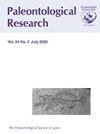伊朗Neyzar地区(Salafchegan东南部)渐新世(Qom组)沉积的生物地层学与古环境
IF 0.6
4区 地球科学
Q3 PALEONTOLOGY
引用次数: 0
摘要
摘要库姆组矿床位于Salafchegan东南12km处(N:34°21′26〃和E:50°32′14〃),厚度为110m。该地层包括薄、中厚层状石灰岩和页岩,覆盖在侵蚀不整合面上方的下红组(渐新世早期)。其上边界被冲积层沉积物覆盖。利用底栖有孔虫的生物地层学分布来确定库姆组的年龄和古环境条件。识别出两个组合带。组合带1和2表明了卢比安-查特期。内陆架(限制性和半限制性泻湖)和中陆架(公海)环境形成于开放式陆架平台上。幼发性条件在研究区卢比安早期和晚期占主导地位。在卢比期中期,光照条件在透光、中光和寡光之间变化。在查特早期和中期,光照条件在寡光、中光到寡光和透光之间变化。在查特期晚期,中生寡光条件占主导地位。此外,在卢比安早期,研究区域的盐度较高(40-50和>50 psu)。卢比安晚期的盐度水平从正常(30–40 psu)到高盐度(40–50 psu)不等。查特阶早期和晚期的盐度是正常的(30–40 psu)。然而,高盐(40–50和>50 psu)和正常(30–40 psu)条件存在于查特岛中部。富营养到中营养的贫营养条件出现在卢比安早期。然而,在卢比安和查特时代的中晚期,中奖杯少奖杯占主导地位。此外,库姆海的古水深在<10m至>20m之间波动。在卢比安-查特时代,藻类和有孔虫组合在研究区域占主导地位。库姆组的一般沉积环境与海草草甸有关。本文章由计算机程序翻译,如有差异,请以英文原文为准。
Biostratigraphy and Paleoenvironments of the Oligocene Deposits (Qom Formation) in the Neyzar Area (Southeast of Salafchegan), Iran
Abstract. The Qom Formation deposits, located at 12 km southeast of Salafchegan (N: 34° 21′ 26″ and E: 50° 32′ 14″), have a thickness of 110 m. The formation includes thin, and medium-to-thick bedded limestone, as well as shale, overlying the Lower Red Formation (early Oligocene) above an erosional unconformity. Its upper boundary is covered by alluvium sediments. Biostratigraphic distributions of benthic Foraminifera were used to determine the age and paleoenvironmental conditions of the Qom Formation. Two assemblage zones were recognized. Assemblage zones 1 and 2 were indicative of a Rupelian–Chattian age. The inner shelf (restricted and semi-restricted lagoons) and middle shelf (open marine) settings were formed on an open shelf platform. Euphotic conditions were dominant during the early and late Rupelian in the studied area. During the middle Rupelian, photic conditions were variable between euphotic and mesophotic to oligophotic. During the early and middle Chattian, photic conditions varied between oligophotic, mesophotic to oligophotic, and euphotic. During the late Chattian, mesophotic-oligophotic conditions were dominant. Additionally, a high level of salinity (40–50 and > 50 psu) was present in the studied area during the early Rupelian. The level of salinity varied from normal (30–40 psu) to hypersaline (40–50 psu) during the late Rupelian. Salinity during early and late Chattian subages was normal (30–40 psu). However, hypersaline (40–50 and > 50 psu) and normal (30–40 psu) conditions were present in the middle Chattian. Eutrophic to mesotrophic-oligotrophic conditions were found in the early Rupelian age. However, mesotrophy-oligotrophy dominated during the middle and late Rupelian and Chattian ages. In addition, the paleo-water depth of the Qom Sea fluctuated from < 10 m to > 20 m. Foralgal and foramol associations are dominant in the studied area during the Rupelian-Chattian ages. The general depositional environment of the Qom Formation is associated with seagrass meadows.
求助全文
通过发布文献求助,成功后即可免费获取论文全文。
去求助
来源期刊

Paleontological Research
PALEONTOLOGY-
CiteScore
1.60
自引率
0.00%
发文量
47
审稿时长
>12 weeks
期刊介绍:
Paleonotological Research (PR) is a quarterly, peer-reviewed international journal, which focuses on original contributions primarily in the area of paleontology but also covering a wide range of allied sciences. It has been published since 1997 as a successor to the former journal Transactions and Proceedings of the Palaeontological Society of Japan. The emphasis of contributions will include global and local perspectives, and contents can cover all ages (Precambrian to the Quaternary, including the present time).
 求助内容:
求助内容: 应助结果提醒方式:
应助结果提醒方式:


